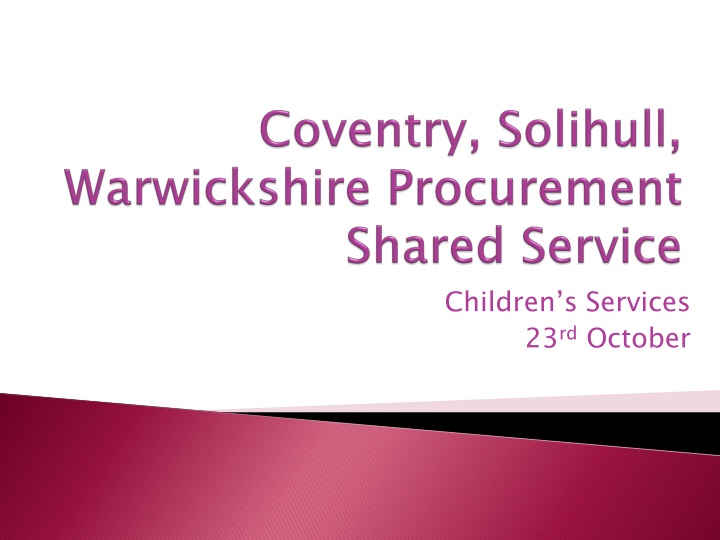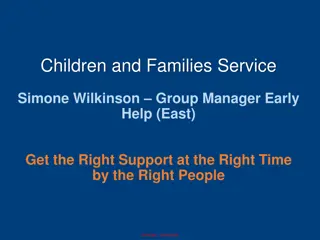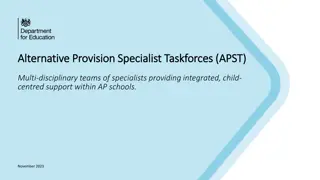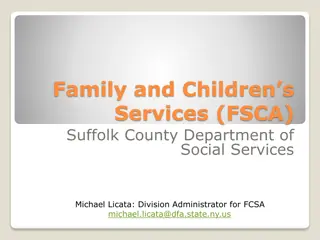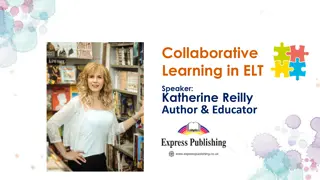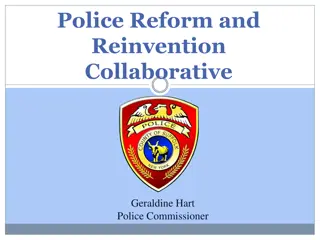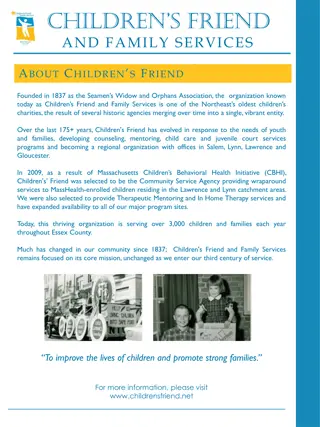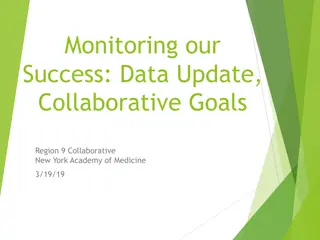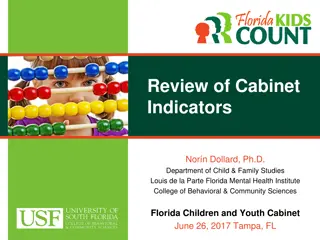Efficiencies Through Collaborative Children's Services
The Children's Services collaboration between Coventry City Council, Solihull Metropolitan Borough Council, and Warwickshire County Council has led to increased procurement power, efficiency gains, and substantial cost savings. Despite challenges stemming from differences in norms and operations, the shared service model has successfully delivered various child-centered contracts. The journey towards this collaborative approach has not been without obstacles, but the shared vision for improved services has prevailed. Through shared expertise and practices, the authorities aim to continue optimizing service delivery for the benefit of children and families.
Download Presentation

Please find below an Image/Link to download the presentation.
The content on the website is provided AS IS for your information and personal use only. It may not be sold, licensed, or shared on other websites without obtaining consent from the author.If you encounter any issues during the download, it is possible that the publisher has removed the file from their server.
You are allowed to download the files provided on this website for personal or commercial use, subject to the condition that they are used lawfully. All files are the property of their respective owners.
The content on the website is provided AS IS for your information and personal use only. It may not be sold, licensed, or shared on other websites without obtaining consent from the author.
E N D
Presentation Transcript
Childrens Services 23rdOctober
In 2010, Coventry City Council (CCC), Solihull Metropolitan Borough Council (SMBC) and Warwickshire County Council (WCC) signed a Memorandum of Understanding and formed the Procurement Shared Service. Warwickshire District Councils were also included1. The authorities have also collaborated regionally2 and nationally3. 1 North Warwickshire Borough Council, Nuneaton and Bedworth Borough Council, Rugby Borough Council, Stratford District Council and Warwick District Council. 2 Framework Agreement for Residential Care Services for Children and Young People. 3 Out of Borough Mechanical and Electrical Works.
Increased procurement power Reduction in duplication of effort and therefore increasing capacity Delivering efficiencies Sharing good practice Expertise being developed in individual authorities Savings
Planned Savings 2,607,000 Planned Savings Actual Savings 7,336,000 Actual Savings First Year (Apr 2010/11) Second Year (Apr 2011/12) Third Year (Apr 2012/13) First Year (Apr 2010/11) Second Year (Apr 2011/12) Third Year (Apr 2012/13) 2,099,000 5,008,000 1,104,000 1,268,000 Table 1. Planned and Actual Savings Made in the CSW Procurement Shared Service Between 2010/11 and 2012/13
The journey has not been made without its difficulties which include: Differences between the political, cultural and structural norms in each authority Providing services in a totally different way in different authorities can also mean structural and operational changes in authorities before the full benefit of shared contracts can be exploited. For economic development, regeneration and growth, CCC and WCC have formed a local enterprise partnership (LEP) whilst SMBC belongs to the Greater Birmingham and Solihull LEP. These issues are not insurmountable but add complexity to any contracts that are let.
The CSW Shared Service has collaborated on numerous Children s contracts including: Fostering Framework Integrated Community Equipment Service CAMHS LAC (Children and Adolescent Mental Health Services for Looked After Children) Independent Adoption Support Service for Birth Family Members
CCC, SMBC and WCC recently conducted data analysis on spend in each authority within the Children s category. The budgets of each authority were aligned which allowed potential areas for combined working and sharing of best practice to be found. The conclusion from the analysis was that combined working had already been complete in the available areas and therefore best practice would be shared in certain areas to try and make savings.
A number of reports have been created recently investigating Fostering Services provided throughout the West Midlands. The data collection revealed the following information.
It was found for Local Authority (internal) fostering services that there was a big range in the unit cost across the 14 West Midlands authorities that were analysed. There was a weak correlation between the OFSTED rating and unit cost which shows as a rule fostering services with lower OFSTED ratings have cheaper unit costs for placements. For more information please contact Nigel Exell (WCC). The report from which this information was sourced used preliminary data and final figures are still to be clarified. Final figures will be released in December 2013.
13 out of the 14 West Midlands authorities that were analysed utilise frameworks with independent fostering associations (IFA). These vary between 1 authority using a framework with 5 suppliers to 6 authorities using a framework with forty-four suppliers. However, there are significant variations in price between the frameworks. For more information please contact Martin Quinn (Warwickshire County Council, WMIEP)
The West Midlands authorities have demonstrated good practice by procuring the vast majority of placements with providers rated as good or outstanding by OFSTED. However, there was no correlation found between the price of placements and a provider s OFSTED rating. It was found that spot placements are considerably more expensive than placements made through the frameworks. However, this may be due to the fact that spot placements include Looked After Children (LAC) who are hardest to place, resulting in bespoke packages at high costs. For more information please contact Martin Quinn (Warwickshire County Council, WMIEP)
Over the last 10 years the number of LAC in the West Midlands has followed the national trend of increasing. Nationally the provision of foster care has increased by 21% between 2002/03 and 2011/12. The independent sector has played the largest part in meeting this new demand in the West Midlands with the share of foster care nights delivered by IFAs rising from 2002/03 to 2011/12. Conversely, the unit costs of IFA placements have reduced over the same period. There is a correlation between when prices reduced and when Staffordshire first let their Fostering Framework. Data sourced from the Audit Commission. The analysis used invoices paid by Councils to the three IFAs with the largest national market share in 2011/12. the size of typical invoices paid to these providers was then typical price paid per placement for these IFAs. calculated. This yielded a crude approximation to the
In March 2013 there were 301 IFAs registered with OFSTED. However, of these there are 175 independent units where 138 were active in 2011/12. The current market structure is likely the change in the medium to long term. Large, national agencies currently account for approximately 40% of the market. There is potential for medium sized groups to extend their geographical coverage as small and medium sized agencies come together to form large groups. Data sourced from the Audit Commission.
CCC, SMBC and WCC have a joint framework contract for fostering services with 12 IFAs. In the first three years of the contract (2010 2013), CCC made 1,495,744 savings, SMBC 693,121 savings and Warwickshire 676,763 savings. Other benefits to the authorities include improving sufficiency and opportunities for supplier development and capacity building analysis. The contract is now in the process of retendering with a new contract commencing on 1st May 2014. A new contract will be created as there is not enough capacity in the current framework. This will result in more suppliers on the framework and greater choice for authorities. There may also be potential savings due to the introduction of a price cap.
Do we know the total cost of acquisition? e.g. how do costs of post 16 fostering placements compare with supported accommodation? E.g. paying transport costs for post 16 attending college, in successful fostering placement rather than 3,000 a week for residential Would the cost of repatriation be cheaper than accommodating 16 plus all appeals exhausted UASC? (how do we start that conversation?) Can we tender for placements on a cost basis i.e. labour, overheads and profit margin? Open book with cost variation being evidenced and agreed without affecting profit margins Can we improve payment processes to make them more efficient for both parties? When negotiations take place on complex needs cases where health is funding is involved how good are we at those negotiations?
Forecasting and communicating future demand key to market shaping Good contract management not monitoring Collecting management information on all placements with one provider not just individual placements Working with providers to see where costs can be taken out of the process Take out reworking of data between different sections Relationship management Have frameworks or contracts in place that can be used in an emergency to avoid paying emergency prices
Through shared working the CSW Shared Service has made significant savings and efficiencies. Through analysis, areas for sharing best practice have been highlighted in the Children s category which will help drive efficiencies and potentially savings. The Fostering Services market is currently developing, in particular the IFA market. The CSW Fostering Framework will shortly be retendered and information regarding the market development should be accounted for to create a framework providing best value for money.
